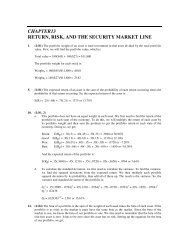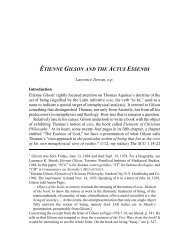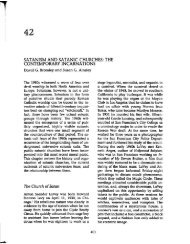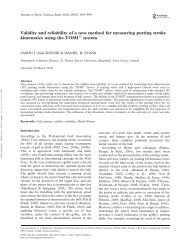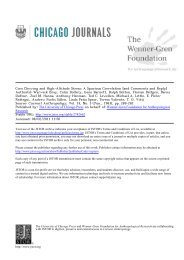Breaking the silence: helping men with erectile dysfunction
Breaking the silence: helping men with erectile dysfunction
Breaking the silence: helping men with erectile dysfunction
You also want an ePaper? Increase the reach of your titles
YUMPU automatically turns print PDFs into web optimized ePapers that Google loves.
CARE OFTHE OLDER PERSON<br />
Table 2. Some factors to consider when rnaking a diagnosis<br />
Precipitation<br />
• Lack of sexual knowledge<br />
• Negative previous sexual<br />
experience(s)<br />
• Relafionship problems<br />
• Religious or cultural beliefs<br />
• Restrictive upbringing<br />
^_____<br />
• Confusion concerning sexual or<br />
gender preference<br />
• Sexual abuse<br />
• Physical or <strong>men</strong>tal healfh problems<br />
• Ofher sexual problems in fhe man<br />
or his partner<br />
• Use of drugs<br />
Predisposing<br />
• New relationship<br />
• Acufe relafionship problems<br />
• Family or social pressures<br />
• Pregnancy and childbirth<br />
• O<strong>the</strong>r major life events<br />
• Partner's <strong>men</strong>opause<br />
• Acute physical or <strong>men</strong>tal health<br />
problems<br />
• Lack of knowledge concerning <strong>the</strong><br />
usual changes of ageing<br />
• Ofher sexual problems in <strong>the</strong> man<br />
or his partner<br />
• Use of drugs<br />
'ource: Adapted from Carson and Dean, 2007; : BSSM, 2008; Carson and McMahon, 2008<br />
Maintenance<br />
' Problems <strong>with</strong> relationship(s)<br />
• Poor communication between<br />
partners<br />
' Knowledge deficit concerning<br />
treat<strong>men</strong>t options<br />
• Long term physical or <strong>men</strong>tal<br />
health problems<br />
' Ofher sexual problems in <strong>the</strong> man<br />
or his partner<br />
• Use of drugs<br />
tionship status (single, married, in a long-term relationship);<br />
a history of previous sexual partners and relationships will<br />
also he required. Sexual orientation and gender identity<br />
should also be noted. The nurse must also ask <strong>the</strong> patient<br />
ahout alcohol, smoking and illicit drug use.<br />
Validated questionnaires are available that will help <strong>the</strong><br />
nurse to make <strong>the</strong> consultation more objective: for example,<br />
<strong>the</strong> International Index of Erectile Function (IIEF)<br />
(Rosen et al, 1997) or <strong>the</strong> validated shorter version of<strong>the</strong><br />
SHIM (Sexual Health Inventory for Men) (Cappelleri and<br />
Rosen, 2005) help to assess sexual function, and also <strong>the</strong><br />
impact of treat<strong>men</strong>ts and interventions. These tools are only<br />
an adjunct to a detailed history and physical examination,<br />
however, <strong>the</strong>y do not replace <strong>the</strong>m.<br />
According to <strong>the</strong> BSSM (2008), <strong>erectile</strong> dysfuncdon and<br />
coronary heart disease have <strong>the</strong> same risk factors. It is important<br />
to note that coronary artery disease is frequently only<br />
one of <strong>the</strong> affected sites in a generalised arteriopathy that<br />
has <strong>the</strong> ability to impact on arterial blood inflow to <strong>the</strong> corpora<br />
cavernosum.The penile arteries are substantially smaller<br />
than <strong>the</strong> main coronary arteries, and <strong>erectile</strong> <strong>dysfunction</strong><br />
frequently pre-dates coronary artery disease (Montorsi et al,<br />
2004), hence <strong>the</strong> need for <strong>the</strong> nurse to approach <strong>the</strong> assess<strong>men</strong>t<br />
of <strong>the</strong> patient fi-om a hoUsdc perspective.<br />
Physical examination<br />
There is controversy concerning <strong>the</strong> need to perform a<br />
physical examination of<strong>the</strong> genitalia. The physical examination<br />
should focus on secondary sexual characteristics, an<br />
abdominal examination, major pulse examination, S2—4<br />
neurological assess<strong>men</strong>t and external genitalia examination.<br />
This type of examination should be undertaken by a specialist<br />
skilled practitioner. The history gained from <strong>the</strong> man<br />
will direct <strong>the</strong> nurse to determine if a physical examination<br />
is required (see Table 3).<br />
The BSSM (2008) suggests that all patients should have a<br />
focused physical examination and a genital examination is<br />
recom<strong>men</strong>ded; this is essential if <strong>the</strong>re is a history of rapid<br />
onset of pain, deviation of<strong>the</strong> penis during tumescence, <strong>the</strong><br />
symptoms of hypogonadism or o<strong>the</strong>r current or past urological<br />
symptoms. If <strong>the</strong> nurse suspects Peyronie's disease<br />
this would merit assess<strong>men</strong>t of <strong>the</strong> peripheral vasculature<br />
(Rané and Fraser, 2007). It is not obligatory to perform a<br />
digital rectal examination; however, this should be considered<br />
if <strong>the</strong>re is evidence of genito-urinary or protracted<br />
secondary ejaculatory symptoms (Carson and McMahon,<br />
2008). Blood pressure, heart rate, waist circumference and<br />
weight should be measured.<br />
O<strong>the</strong>r investigations may be indicated and are tailored<br />
to <strong>the</strong> needs of <strong>the</strong> patient after an in-depth assess<strong>men</strong>t<br />
Table 3. Individual examination and assess<strong>men</strong>t<br />
Assess general appearance.<br />
Are <strong>the</strong>re signs of<br />
o<strong>the</strong>r illnesses:<br />
Assess secondary sexual<br />
characteristics:<br />
Assess genitalia:<br />
Assess physical parameters.<br />
Measure:<br />
• Depression<br />
•Thyroid problems<br />
• Parkinson's disease<br />
• Distribution of body hair (facial, pubic,<br />
body)<br />
• Muscle develop<strong>men</strong>t<br />
• Distribution of body fat<br />
• Observe, palpate and examine penile<br />
shaft, foreskin (if present)<br />
• Any evidence of swelling, lumps, tenderness<br />
• Any evidence of sexually transmitted<br />
infection<br />
• Inspect and palpate scrotal sac and<br />
contents (what size are <strong>the</strong> testes develop<strong>men</strong>tally)<br />
• Blood pressure<br />
• Heart rate<br />
•Waist circumference<br />
•Weight<br />
Source: Adapted from Carson and Dean, 2007; BSSM, 2008<br />
British Journal of Community Nursing Vol 17, No 7 315



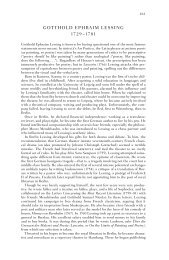

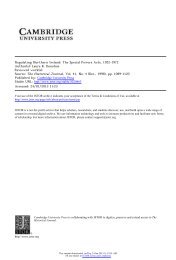

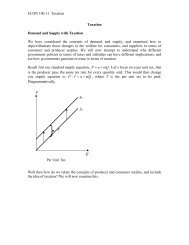
![The Rink - Cyril Dabydeen[1].pdf](https://img.yumpu.com/21946808/1/155x260/the-rink-cyril-dabydeen1pdf.jpg?quality=85)

